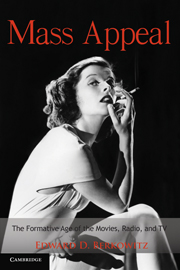Book contents
- Frontmatter
- Contents
- Acknowledgments
- Introduction
- 1 Sound Comes In, Vaudeville and Silent Pictures Go Out
- 2 From Broadway to Hollywood with Groucho, Fred, and Ginger
- 3 Radio Nights
- 4 From the Thirties to the Forties with Kate, Bud, and Lou
- 5 Bogie, Bob, and the Boys at War
- 6 The Postwar Movie Scene
- 7 Make Room for TV
- 8 Putting It Together: Walt Disney Introduces the Baby Boom to Television
- 9 The End of an Era?
- Notes
- Movie, Radio, and TV Listings
- Index
8 - Putting It Together: Walt Disney Introduces the Baby Boom to Television
Published online by Cambridge University Press: 05 June 2012
- Frontmatter
- Contents
- Acknowledgments
- Introduction
- 1 Sound Comes In, Vaudeville and Silent Pictures Go Out
- 2 From Broadway to Hollywood with Groucho, Fred, and Ginger
- 3 Radio Nights
- 4 From the Thirties to the Forties with Kate, Bud, and Lou
- 5 Bogie, Bob, and the Boys at War
- 6 The Postwar Movie Scene
- 7 Make Room for TV
- 8 Putting It Together: Walt Disney Introduces the Baby Boom to Television
- 9 The End of an Era?
- Notes
- Movie, Radio, and TV Listings
- Index
Summary
The movie industry faced a difficult task in the postwar era. It had to keep people interested in what was playing at the local theater while forging a relationship with a growing television industry that was keeping people at home. In this touchy period, no one negotiated the relationship between the movies and television better than Walt Disney. The famous animator and film producer made television shows that promoted movies and movies that were taken directly from television shows. At the same time, he used television to introduce something new – the studio as amusement park – that featured characters from his movies and television shows.
In the 1950s, Disney enjoyed such a fine reputation that he made it onto a list of the “world’s 100 most important living persons.” Those who shared the honor with Disney in the arts and letters category included novelists Ernest Hemingway and William Faulkner, poet T. S. Eliot, composer Igor Stravinsky, and painter Pablo Picasso. Such honors came on top of the ones he had earned in the 1930s for creating the Mickey Mouse cartoons and producing the full-length animated feature Snow White and the Seven Dwarfs. Yale University confirmed the world’s admiration for Disney by awarding him an honorary degree in 1938. At the time, Hollywood columnist Hedda Hopper called Disney an “authentic genius” who was nonetheless “the most down-to-earth guy I know.”
- Type
- Chapter
- Information
- Mass AppealThe Formative Age of the Movies, Radio, and TV, pp. 131 - 152Publisher: Cambridge University PressPrint publication year: 2010

